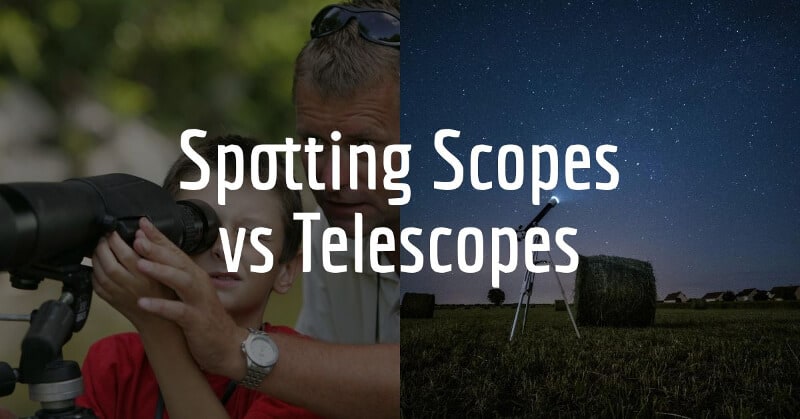When most people think about getting into astronomy they assume that they need a telescope.
However, spotting scopes have a number of advantages that can make them a good alternative option to telescopes for some people.
In this article, we explore the pros and cons of spotting scope vs telescope to help you decide what is right for you.
Our focus is in relation to astronomy and astrophotography, but we also touch on other terrestrial uses.
Spotting Scope vs Telescope: What’s the Difference?
Spotting Scopes can be very similar to certain telescopes, and very different from others, as there are three main types of astronomical telescopes that differ fairly substantially. These are:
- Refractors,
- Reflectors, and
- Catadioptrics
In general, a spotting scope is a relatively small optical device that uses lenses to give you a magnified view of objects in the distance:
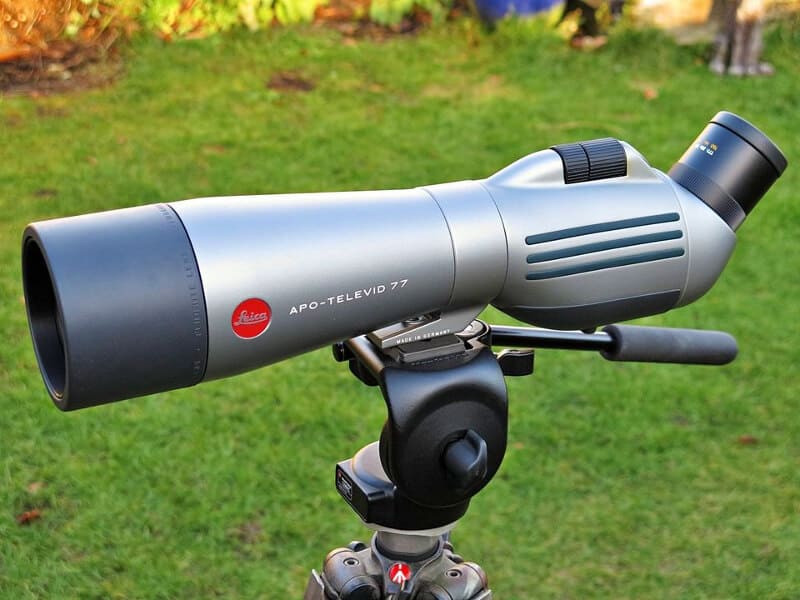
They are generally for daytime (terrestrial) use like bird watching, hunting, shooting, or ocean viewing, but can be used for astronomy, as we outline below.
You can find them as either an angled spotting scope or a straight spotting scope, and we touch on the implications of this for looking up at the night sky further on.
Spotting Scope vs Telescope: Refractors
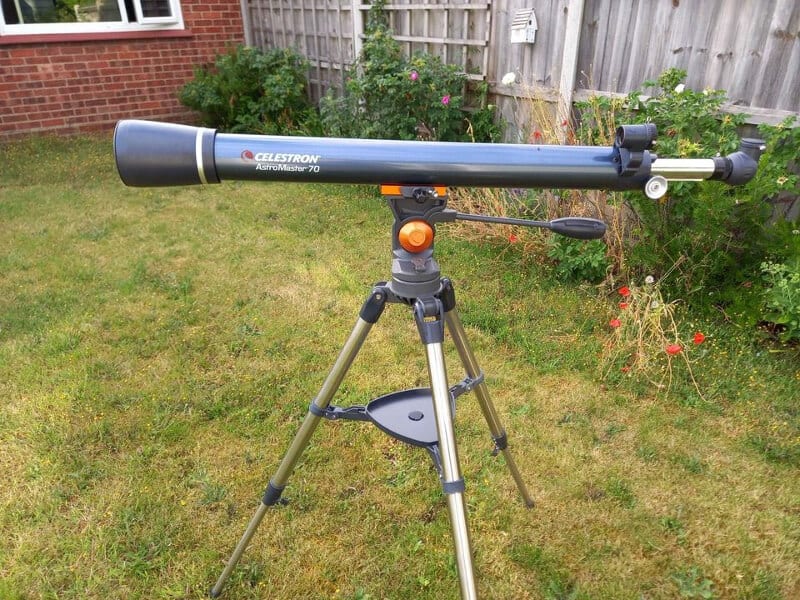
Spotting scopes are very similar to refractor telescopes.
Refractor telescopes use lenses and have the same structural design where you look in the eyepiece at one end and see out the other.
Spotting Scope vs Telescope: Catadioptric
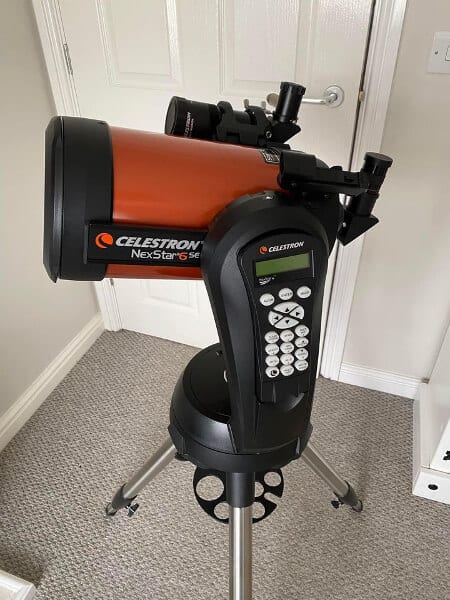
Catadioptric (or “compound”) telescopes use a combination of lenses and mirrors.
This is unlike most conventional spotting scopes that house just lenses, but there are spotting scopes that use the catadioptric telescope design and are very similar to astronomical telescopes.
In fact, some spotting scopes like these from Celestron are actually repackaged astronomical telescopes and are the best spotting scopes for astronomy. Most regular spotting scopes are not like this though.
Spotting Scope vs Telescope: Reflectors
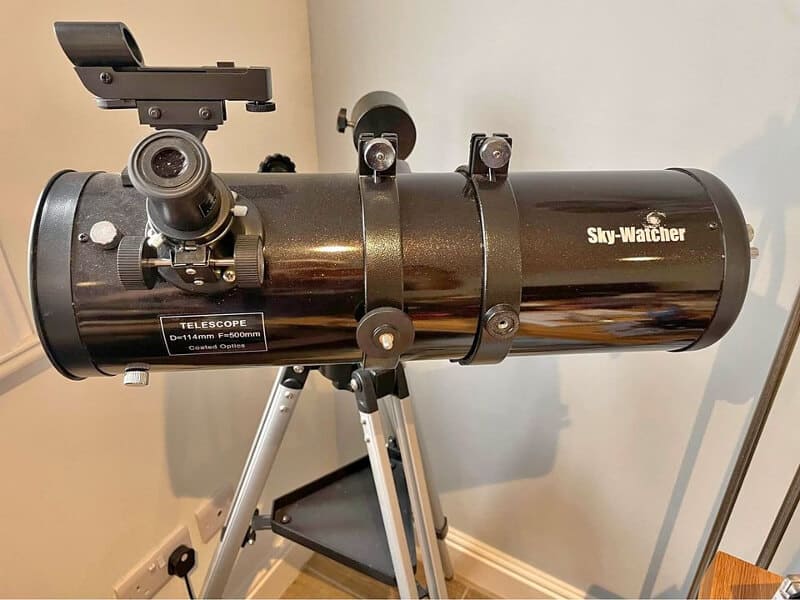
Finally, spotting scopes differ considerably from the third main telescope type, reflector telescopes.
These use mirrors and are generally considerably larger and have the eyepiece on the side and at the top of the telescope tube as it stands.
If you want to understand different telescope types more, see our article on reflector vs refractor telescopes.
Spotting Scope vs Telescope for Astronomy
Now let’s look at how spotting scopes and telescopes compare in terms of key characteristics for stargazing and other uses.
Aperture
The key measurement that indicates the image quality of the views a spotting scope or telescope will provide of the night sky is aperture.
This is the measurement of the objective lens diameter and the bigger this is, the better the views will be in low light.
This is because larger lenses capture more light in dark skies and provide brighter and clearer images.
This measurement is nearly always indicated in the name of the model of the spotting scope or telescope, either in millimeters or inches. For example:
- Celestron C5 Spotting Scope (a catadioptric scope) – 5-inch (127mm) aperture
- Vortex Optics Razor HD 27-60×85 Spotting Scope – 85mm aperture (27-60 indicates the magnification – more on this below)
- Orion StarBlast 62mm Telescope – 62mm aperture
Both spotting scopes and telescopes can have low and high apertures and, in general, the higher this is the more expensive it will be.
Magnification
The other indicator often given in the model name of spotting scopes is magnification.
This is the measurement of how many times closer the object you are viewing will appear.
It is not always the case that higher magnification is better though, especially for astronomy, as it will also magnify any flaws in your view or just zoom you into a dim object if the aperture is not high enough.
High magnification also correlates with a narrow field of view – this is great for zooming into relatively small objects like the moon, but not so much for looking at large deep-sky objects where you will want a wider field of view and lower magnification.
Magnification power is usually indicated in the model name of spotting scopes, but not for telescopes. The reason for this is that spotting scopes tend to have fixed eyepieces that dictate the magnification (this may be a zoom eyepiece so you can vary it within a certain range). However, telescopes for astronomy nearly always have interchangeable eyepieces that can vary the magnification to a much larger extent.
Some spotting scopes for astronomy from Celestron and Orion do allow interchangeable astronomical eyepieces though – see those in our article on the Best Spotting Scopes for Astronomy.
Size, weight, and portability
Spotting scopes tend to be small, compact and fairly light. They are intended to be taken out into the field for use bird-watching or hunting, etc. They also usually come with suitable outdoor carry cases.
Telescopes can vary greatly in terms of size and weight. There are some great portable travel telescopes but often telescopes are bulky, cumbersome and heavy.
Versatility (terrestrial and celestial use)
Spotting scopes are generally intended to be used in the daytime for terrestrial viewing. They have either a straight or angled eyepiece that is perfect for use when looking out roughly at the horizon – as you would with ocean viewing, shooting, birding, etc. They also fit on regular camera tripods.
So, whilst spotting scopes can be used for stargazing and astronomy, this design is a fairly major downside as it results in a literal pain in the neck.
In contrast, astronomical telescopes are designed to look directly up at the night sky and the eyepieces are angled in such a way to allow comfortable viewing for long periods.
However, the downside of astronomical telescopes is that they may not be suitable for daytime use and, similarly, the eyepiece positioning will not be ideal for looking out level with the horizon.
Durability
Spotting scopes are nearly always designed to be hardy, waterproof and weatherproof. This is because they are often intended to be taken out in less-than-perfect conditions and maybe used in the rain.
In contrast, telescopes are rarely waterproof/weatherproof. This is because when it is rainy it is also cloudy and therefore you have no clear skies, so it is not seen as needed.
An additional aspect of this is that spotting scopes often come with a longer warranty than telescopes because they are supposed to be hardy and last long.
Image Orientation
One thing to consider is that for many telescopes, the view you see is actually upside down. This might not matter for many astronomical objects you are looking at, but it is another reason why a telescope will not be good for pursuits like bird-watching.
Price
There are big variations in price, but spotting scopes tend to be cheaper than telescopes.
There are, however, there are premium spotting scopes from brands like Swarovski, Zeiss, and Leica that are very expensive, and there are also budget telescopes for beginners that are cheaper.
Overall: Spotting Scopes vs Telescopes for Astronomy
Overall, spotting scopes do hold a number of advantages over telescopes:
- They are smaller, lighter, and easier to handle. It’s generally a much simpler affair with less accessories.
- They are more portable and usually come with suitable bags for carrying them.
- They can be used for both day and nighttime viewing.
- They are hardy and weatherproof.
- They usually come with longer warranties.
- They are usually cheaper.
- They adjust to cooler outside temperatures quickly (unlike some telescopes where you have to wait a while)
However, there are definitely a number of disadvantages for spotting scopes in comparison to telescopes:
- The way you look through a spotting scope is not optimized for up at the sky and will be uncomfortable for anything beyond a very short period (note though that some Celestron spotting scopes can fit telescope diagonals to bypass this problem).
- The majority of regular spotting scopes have in-built eyepieces that cannot be changed and this may not be great for astronomy (however, again, some models from Celestron and Orion do allow this).
- There are limits on the aperture that spotting scopes will go up to, which will limit the image quality you can have for astronomy.
Overall, spotting scopes are less tailored for astronomy than telescopes, but spotting scopes are more versatile and generally easier to use.
Spotting Scope vs Telescope: FAQs
Spotting Scopes vs Telescopes for Birding, Hunting & Ocean Viewing
A friend of mine recently moved into an apartment with a sea view and he asked what telescope would be best for looking out to the ocean. I said I had no idea as I only knew about looking at the stars.
Since doing this research though, I now know that a spotting scope would be ideal for what he was after.
Similarly, spotting scopes are perfect for bird watching, hunting, and shooting where you are land viewing and looking at a distant object. They are designed for this in a way that most telescopes are not.
Another option to consider is monoculars, which are even more compact and portable than spotting scopes.
Spotting Scopes vs Telescopes for Astrophotography
Telescopes will almost always be better than spotting scopes for astrophotography – see the best telescopes for astrophotography if you want more on this.
Some of the best spotting scopes for astronomy will also be good for this though, and some of the Celestron models allow DSLR or mirrorless cameras to be directly attached, whereas most smaller models will be suitable only for smartphone astrophotography.
Spotting Scopes vs Telescopes for Kids
If you are looking for a bit of astronomy gear for a child, then a spotting scope makes sense – they are easier to use, sturdier, and less expensive.
As concluded above, they will not be overall as good for stargazing as a telescope, but these advantages listed above might make them the right choice for some people.
If you are looking for a telescope for a child, see our article on the Best Telescopes for Kids.
Spotting scopes vs Binoculars?
Binoculars are essentially two spotting scopes held together. For this reason, they have one main advantage – you can see through both eyes.
But for the same reason, they also have two notable disadvantages – they are heavier and more expensive, simply because they are more gear.
Note though, that you can get some spotting scopes with dual eyepieces – see here.
For more detail on this topic, see Spotting Scopes vs Binoculars for Astronomy: Which is Best?
To read more on binoculars, see the Best Astronomy Binoculars.
Final Word: Telescope vs Spotting Scope
Overall, there are some advantages to using a spotting scope over a telescope for astronomy:
- It is often a much simpler affair with fewer accessories involved,
- You have something versatile for daytime and night sky use, and
- They tend to be cheaper.
However, telescopes are much more tailored for astronomy and stargazing and better suited for this pursuit.
The downside of telescopes is that they are less versatile for other uses, less portable, and more expensive.
Related articles:


